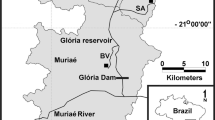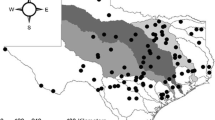Abstract
In freshwater ecosystems, spatial turnover in fish assemblages is often attributed to dispersal limitation imposed by fragmentation of water bodies. Other factors like environmental properties or biotic interactions have often been assumed to be minute relative to dispersal limitation when hydrogeological barriers are abundant. This study aims to describe the spatial differentiation of cichlid fish assemblages in the upper río Madera in Bolivia, Brazil and Perú, a large drainage system characterized by the absence of significant hydrogeological barriers. We assessed the relative importance of spatial, climatic and geological predictors in the observed biogeographic structure using an integrative combination of cluster analyses, elements of metacommunity structure analysis, variation partitioning, and network analysis. Our results show that distinct assemblages of cichlid fish species replace each other across the landscape and that this turnover is partially determined by climate and geological gradients. A considerable fraction of the cichlid assembly structure could not be assigned to either space, climate or geology and might be explained by unmeasured parameters such as habitat structure or biotic interactions. Incorporating knowledge on spatial turnover of species assemblages into conservation strategies will be essential for the biodiversity management of the diverse aquatic fauna of the upper río Madera.







Similar content being viewed by others
References
Arrington, D. A., K. O. Winemiller & C. A. Layman, 2005. Community assembly at the patch scale in a species rich tropical river. Oecologia 144: 157–167.
Blanchet, F. G., P. Legendre & D. Borcard, 2008. Forward selection of explanatory variables. Ecology 89: 2623–2632.
Borcard, D., P. Legendre, C. Avois-Jacquet & H. Tuomisto, 2004. Dissecting the spatial structure of ecological data at multiple scales. Ecology 85: 1826–1832.
Borcard, D., P. Legendre & P. Drapeau, 1992. partialling out the spatial component of ecological variation. Ecology 73: 1045–1055.
Carvajal-Vallejos, F. M. & A. J. Zeballos Fernández, 2011. Diversidad y distribución de los peces de la Amazonía boliviana Peces y Delfines de la Amazonía boliviana: Hábitats, potencialidades y amenazas. Cochabamba, Bolivia: 101–147.
Carvajal-Vallejos, F. M., R. Bigorne, A. J. Zeballos Fernández, J. Sarmiento, S. Barrera, T. Yunoki, M. Pouilly, J. Zubieta, E. De La Barra, M. Jegú, M. Maldonado, P. Van Damme, R. Céspedes & T. Oberdorff, 2014. Fish-AMAZBOL: a database on freshwater fishes of the Bolivian Amazon. Hydrobiologia 732: 19–27.
Chase, J. M. & M. A. Leibold, 2003. Ecological Niches: Linking Classical and Contemporary Approaches. The University of Chicago Press, Chicago, IL.
Chernoff, B., A. Machado, A. Phil, W. Jaime, S. Soraya, A. Machado-allison, P. Willink, J. Sarmiento, & S. Barrera, 2000. Fishes of three Bolivian rivers: Diversity, distribution and conservation. Interciencia 25: 273–283.
Clements, F. E., 1916. Plant Succession, An Analysis of the Development of Vegetation. Carnegie Institution, Washington, DC.
Cottenie, K., 2005. Integrating environmental and spatial processes in ecological community dynamics. Ecology Letters 8: 1175–1182.
Crampton, W. G. R., 2011. An Ecological Perspective on Diversity and Distributions. University of California Press, Berkeley.
Dallas, T., 2014. Metacom: an R package for the analysis of metacommunity structure. Ecography 37: 402–405.
Dijkshoorn, J. A., J. R. M. Huting, & P. Tempel, 2005. Update of the 1:5 million soil nd terrain database for Latin America and the Caribbean (SOTERLAC), version 2.0. ISRIC, Wageningen.
Dray, S., P. Legendre & P. R. Peres-Neto, 2006. Spatial modelling: a comprehensive framework for principal coordinate analysis of neighbour matrices (PCNM). Ecological Modelling 196: 483–493.
Epskamp, S., A. O. J. Cramer, L. J. Waldorp, V. D. Schmittmann & D. Borsboom, 2012. qgraph: network visualizations of relationships in psychometric data. Journal of Statistical Software 48: 1–18.
Farias, I. P., J. P. Torrico, C. García-Dávila, M. D. C. F. Santos, T. Hrbek & J. F. Renno, 2010. Are rapids a barrier for floodplain fishes of the Amazon basin? A demographic study of the keystone floodplain species Colossoma macropomum (Teleostei: characiformes). Molecular Phylogenetics and Evolution 56: 1129–1135.
Göthe, E., D. G. Angeler, S. Gottschalk, S. Löfgren & L. Sandin, 2013. The influence of environmental, biotic and spatial factors on diatom metacommunity structure in swedish headwater streams. PLoS One 8: e72237.
Goulding, M., 1979. Ecologia da pesca do rio Madeira. INPA, Manaus.
Hablützel, P. I., T. Yunoki & L. T. Velasco, 2013. List update on the checklist of fish species of the Bolivian Amazon. Check List 9: 208–210.
Hijmans, R. J., S. E. Cameron, J. L. Parra, P. G. Jones & A. Jarvis, 2005. Very high resolution interpolated climate surfaces for global land areas. International Journal of Climatology 25: 1965–1978.
Hubert, N. & J. F. Renno, 2006. Historical biogeography of South American freshwater fishes. Journal of Biogeography 33: 1414–1436.
Kesner-Reyes, K., K. Kaschner, S. Kullander, C. Garilao, J. Barile, & R. Froese, 2012. AquaMaps: algorithm and data sources for aquatic organisms In Froese, R., & D. Pauly (eds), FishBase (version 04/2012). www.fishbase.org.
Kullander, S. O., 1986. Cichlid Fishes of the Amazon River Drainage of Peru. Swedish Museum of Natural History, Stockholm.
Lauzanne, L., G. Loubens, & B. Le Guennec, 1991. Liste commentée des poissons de l’Amazonie bolivienne. Revue d’Hydrobiologie Tropicale 24: 61–76.
Legendre, L., & P. Legendre, 1998. Numerical Ecology. Elsevier, Amsterdam.
Legendre, P., & E. D. Gallagher, 2001. Ecologically meaningful transformations for ordination of species data. Oecologia 129: 271–280.
Legendre, P., D. Borcard & P. R. Peres-Neto, 2005. Analyzing beta diversity: partitioning the spatial variation of community composition data. Ecological Monographs 75: 435–450.
Leibold, M. & G. M. Mikkelson, 2002. Coherence, species turnover, and boundary clumping: elements of meta-community structure. Oikos 97: 237–250.
López-Fernández, H., R. L. Honeycutt & K. O. Winemiller, 2005. Molecular phylogeny and evidence for an adaptive radiation of geophagine cichlids from South America (Perciformes: Labroidei). Molecular Phylogenetics and Evolution 34: 227–244.
López-Fernández, H., K. O. Winemiller & R. L. Honeycutt, 2010. Multilocus phylogeny and rapid radiations in Neotropical cichlid fishes (Perciformes: Cichlidae: Cichlinae). Molecular Phylogenetics and Evolution 55: 1070–1086.
Lundberg, J. G., L. G. Marshall, J. Guerrero, B. Horton, M. C. S. L. Malabarba, & F. Wesselingh, 1998. The stage for Neotropical fish diversification: a history of tropical South American rivers In Malabarba, L. R., R. E. Reis, R. P. Vari, Z. M. S. Lucena, & C. A. S. Lucena (eds), Phylogeny and Classification of Neotropical Fishes. EDIPUCRS, Porto Alegre, pp. 13–48.
Meier, E. S., F. Kienast, P. B. Pearman, J. C. Svenning, W. Thuiller, M. B. Araújo, A. Guisan & N. E. Zimmermann, 2010. Biotic and abiotic variables show little redundancy in explaining tree species distributions. Ecography 33: 1038–1048.
Muñoz Puelles, L., A. B. Gill, K. Osinaga, & H. L. Perotto-Baldivieso, 2016. Floodplain fish communities in river systems in Bolivia: Current knowledge and addressing future research challenges. Ecología en Bolivia 51: 26–41.
Montaña, C. G. & K. O. Winemiller, 2010. Local-scale habitat influences morphological diversity of species assemblages of cichlid fishes in a tropical floodplain river. Ecology of Freshwater Fish 19: 216–227.
Montoya-Burgos, J. I., 2003. Historical biogeography of the catfish genus Hypostomus (Siluriformes: Loricariidae), with implications on the diversification of Neotropical ichthyofauna. Molecular Ecology 12: 1855–1867.
Navarro, G. & M. Maldonado, 2002. Geografía ecológica de Bolivia: Vegetación y Ambientes Acuáticos. Centro de Ecología Simón I, Patiño - Departamento de Difusión, Cochabamba.
Oksanen, J., R. Kindt, P. Legendre, & R. B. O’Hara, 2007. Vegan: Community Ecology Package, Version 1.8-6, http://cran.r-project.org.
Olden, J. D., M. J. Kennard, F. Leprieur, P. A. Tedesco, K. O. Winemiller & E. García-Berthou, 2010. Conservation biogeography of freshwater fishes: recent progress and future challenges. Diversity and Distributions 16: 496–513.
Padial, A. A., F. Ceschin, S. A. J. Declerck, L. De Meester, C. C. Bonecker, F. A. Lansac-Tôha, L. Rodrigues, L. C. Rodrigues, S. Train, L. F. M. Velho & L. M. Bini, 2014. Dispersal ability determines the role of environmental, spatial and temporal drivers of metacommunity structure. PLos One 9: e111227.
Pearson, N. E., 1937. The fishes of the Beni-Mamoré and Paraguay basin, and a discussion of the origin of the Paraguayan fauna. Proceedings of the Californian Academy of Sciences 23: 99–114.
Peres-Neto, P. R., P. Legendre, S. Dray & D. Borcard, 2006. Variation partitioning of species data matrices: estimation and comparison of fractions. Ecology 87: 2614–2625.
Pouilly, M., M. Jégu, J. Camacho Terrazas, M. Quintilla Palacios, G. Miranda Chumacero, J. P. Zubieta Zubieta & T. Yunoki, 2010. Lista actualizada y distribución de los peces en las tierras bajas de la Amazonía Boliviana. Revista Boliviana de Ecología y Conservación Ambiental 28: 73–97.
Rae, D. A., W. S. Armbruster, M. E. Edwards & M. Svengård-Barre, 2006. Influence of microclimate and species interactions on the composition of plant and invertebrate communities in alpine northern Norway. Acta Oecologica 29: 266–282.
R Development Core Team, 2011. R: A Language and Environment for Statistical Computing. R Foundation for Statistical Computing, Vienna. http://www.r-project.org/.
Sarmiento, J., & S. Barrera, 2004. Fish In Ibisch, P. L., & G. Mérida (eds), Biodiversity: the richness of Bolivia - State of knowledge and conservation. Ministry of Sustainable Development, Editorial FAN, Santa Cruz de la Sierra, Bolivia, pp. 122–128.
Tedesco, P., A. C. Ibañez, N. Moya, R. Bigorne, J. Camacho, E. Goitia, B. Hugueny, M. Maldonado, M. Rivero, S. Tomanová, J. P. Zubieta & T. Oberdorff, 2007. Local-scale species-energy relationships in fish assemblages of some forested streams of the Bolivian Amazon. Comptes rendus biologies 330: 255–264.
Van Damme, P. A., F. Carvajal-Vallejos, M. Pouilly, T. Perezi, & J. Molino Cario, 2011. Amenazas para los peces y las pesquerías de la amazonía boliviana In Van Damme, P. A., F. Carvajal, & J. Molina (eds), Los peces y delfines de la Amazonía boliviana: hábitats, potencialidades y amenazas. INIA, Cochabamba, pp. 327–366.
Vari, R. P., & L. R. Malabarba, 1998. Neotropical ichthyology: an overview. In Malabarba, L. R., R. E. Reis, R. P. Vari, Z. M. S. Lucena, & C. A. S. Lucena (eds), Phylogeny and Classification of Neotropical Fishes. EDIPUCRS, Porto Alegre, pp. 1–11.
Wang, B., A. M. Mezlini, F. Demir, M. Fiume, Z. Tu, M. Brudno, B. Haibe-Kains & A. Goldenberg, 2014. Similarity network fusion for aggregating data types on a genomic scale. Nature Methods 11: 333–337.
Whittaker, R. H., 1960. Vegetation of the Sisiyou Mountains, Orgeon and California. Ecological Monographs 30: 279–338.
Wilkinson, J. M., J. G. Lundberg, & L. G. Marshall, 2006. River behavior on megafans and potential influences on diversification and distribution of aquatic organisms. Journal of South American Earth Sciences. 21(1): 151–172.
Willis, S. C., H. López-Fernández, C. G. Montaña, I. P. Farias & G. Ortí, 2012. Species-level phylogeny of “Satan”s perches’ based on discordant gene trees (Teleostei: cichlidae: Satanoperca Günther 1862). Molecular Phylogenetics and Evolution 63: 798–808.
Winemiller, K. O., H. López-Fernández, D. C. Taphorn, L. G. Nico & A. B. Duque, 2008. Fish assemblages of the Casiquiare River, a corridor and zoogeographical filter for dispersal between the Orinoco and Amazon basins. Journal of Biogeography 35: 1551–1563.
Acknowledgements
We thank Takayuki Yunoki and Luis Torres (CIRA, University of Beni, Bolivia), Karina Osinaga and Kathia Riveiro (MNK, Santa Cruz, Bolivia), Soraya Barrera and Jaime Sarmiento (CBF, Bolivia) for their hospitality during research visits and granting access to their collections. We also thank Robert Guggenbühl and Wolfgang Staeck for providing additional information on cichlid species distribution. Many thanks to Nele Boon for statistical advice. Two anonymous reviewers provided helpful suggestions on an earlier version of the manuscript. Our research was supported by Grants to PIH from the Deutsche Cichliden-Gesellschaft (DCG) and the Swiss Academy of Natural Sciences.
Author information
Authors and Affiliations
Corresponding author
Additional information
Guest editors: S. Koblmüller, R. C. Albertson, M. J. Genner, K. M. Sefc & T. Takahashi / Advances in Cichlid Research II: Behavior, Ecology and Evolutionary Biology
Electronic supplementary material
Below is the link to the electronic supplementary material.
Rights and permissions
About this article
Cite this article
Hablützel, P.I., Pantel, J.H. Strong spatial turnover in cichlid fish assemblages in the upper río Madera (Amazon basin) despite the absence of hydrological barriers. Hydrobiologia 791, 221–235 (2017). https://doi.org/10.1007/s10750-016-2853-0
Received:
Revised:
Accepted:
Published:
Issue Date:
DOI: https://doi.org/10.1007/s10750-016-2853-0




